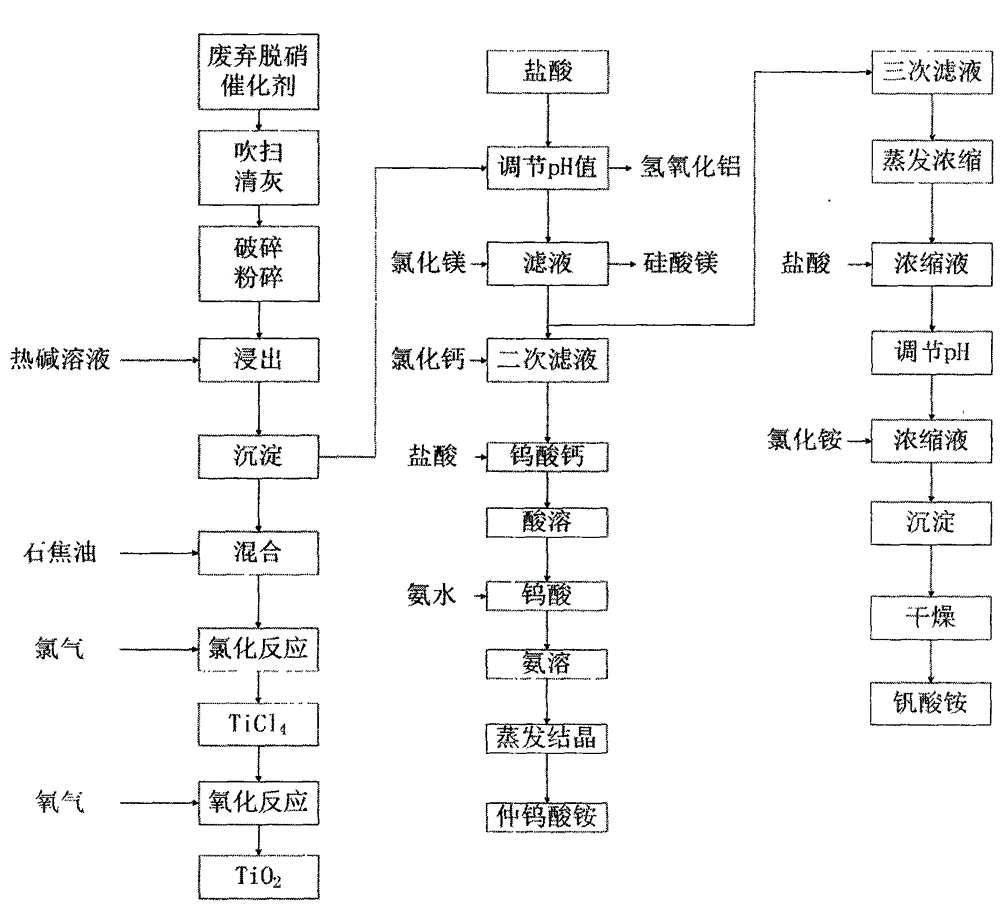Recycling method for waste denitration catalyst
A denitration catalyst and recycling technology, applied in the fields of tungsten, vanadium and titanium metal oxide recovery respectively, can solve the problems of waste water, waste gas and waste residue, discouragement and other problems, achieve less discharge of three wastes, short production process, economical easy effect
- Summary
- Abstract
- Description
- Claims
- Application Information
AI Technical Summary
Problems solved by technology
Method used
Image
Examples
Embodiment 1
[0021] (1) After the waste denitration catalyst is purged and dust-cleaned, it is crushed with a jaw crusher, and then crushed into a 100-200-mesh powder with a pulverizer;
[0022] (2) Add the waste denitrification catalyst powder to a strong alkali solution with a mass percentage of 30%, and at the same time add 1% hydrogen peroxide solution, react at a temperature of 80°C and a stirring speed of 500 rpm for 4 hours, and centrifuge Obtain titanium-rich material and a solution containing sodium vanadate, sodium tungstate, sodium silicate and sodium metaaluminate, and the mass ratio of waste denitration catalyst powder to strong base is 2:2;
[0023] (3) fully mix the titanium-rich material and petroleum tar obtained in step (2), react the mixture of titanium-rich material and petroleum tar with chlorine gas, generate titanium tetrachloride flue gas, TiO in the titanium-rich material in this reaction 2 The molar ratio of petroleum tar (C) is 1:1, TiO 2 The molar ratio of chlo...
Embodiment 2
[0027] (1) After the waste denitration catalyst is purged and dust-cleaned, it is crushed with a jaw crusher, and then crushed into a 100-200-mesh powder with a pulverizer;
[0028] (2) Add the waste denitrification catalyst powder to a strong alkali solution with a mass percentage of 30%, and at the same time add 1% hydrogen peroxide solution, react at a temperature of 85°C and a stirring speed of 550 rpm for 4.5 hours, and centrifuge Obtain titanium-rich material and a solution containing sodium vanadate, sodium tungstate, sodium silicate and sodium metaaluminate, and the mass ratio of waste denitration catalyst powder to strong base is 2:1.5;
[0029] (3) fully mix the titanium-rich material and petroleum tar obtained in step (2), react the mixture of titanium-rich material and petroleum tar with chlorine gas, generate titanium tetrachloride flue gas, TiO in the titanium-rich material in this reaction 2 And the molar ratio of petroleum tar (C) is 1:1.5, TiO 2 The molar rat...
Embodiment 3
[0033] (1) After the waste denitration catalyst is purged and dust-cleaned, it is crushed with a jaw crusher, and then crushed into a 100-200-mesh powder with a pulverizer;
[0034] (2) Add the waste denitrification catalyst powder to a strong alkali solution with a mass percentage of 30%, and at the same time add 1% hydrogen peroxide solution, and react for 5.0 hours at a temperature of 90°C and a stirring speed of 600 rpm, and centrifuge Obtain titanium-rich material and a solution containing sodium vanadate, sodium tungstate, sodium silicate and sodium metaaluminate, and the mass ratio of waste denitration catalyst powder to strong base is 2:1;
[0035] (3) fully mix the titanium-rich material and petroleum tar obtained in step (2), react the mixture of titanium-rich material and petroleum tar with chlorine gas, generate titanium tetrachloride flue gas, TiO in the titanium-rich material in this reaction 2 The molar ratio of petroleum tar (C) is 1:2, TiO 2 The molar ratio w...
PUM
 Login to View More
Login to View More Abstract
Description
Claims
Application Information
 Login to View More
Login to View More - R&D
- Intellectual Property
- Life Sciences
- Materials
- Tech Scout
- Unparalleled Data Quality
- Higher Quality Content
- 60% Fewer Hallucinations
Browse by: Latest US Patents, China's latest patents, Technical Efficacy Thesaurus, Application Domain, Technology Topic, Popular Technical Reports.
© 2025 PatSnap. All rights reserved.Legal|Privacy policy|Modern Slavery Act Transparency Statement|Sitemap|About US| Contact US: help@patsnap.com

